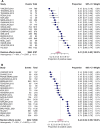High-level burnout in physicians and nurses working in adult ICUs: a systematic review and meta-analysis
- PMID: 36971792
- PMCID: PMC10041519
- DOI: 10.1007/s00134-023-07025-8
High-level burnout in physicians and nurses working in adult ICUs: a systematic review and meta-analysis
Abstract
Purpose: The prevalence of burnout in intensive care unit (ICU) professionals is difficult to establish due to the variety of survey instruments used, the heterogeneity of the targeted population, the design of the studies, and the differences among countries regarding ICU organization.
Methods: We performed a systematic review and meta-analysis examining the prevalence of high-level burnout in physicians and nurses working in adult ICUs, including only studies that use the Maslach Burnout Inventory (MBI) as a tool to evaluate burnout and involving at least 3 different ICUs.
Results: Twenty-five studies with a combined population of 20,723 healthcare workers from adult ICUs satisfied the inclusion criteria. Combining 18 studies including 8187 ICU physicians, 3660 of them reported a high level of burnout (prevalence 0.41, range 0.15-0.71, 95% CI [0.33; 0.5], I2 97.6%, 95% CI [96.9%; 98.1%]). The heterogeneity can be at least in part explained by the definition of burnout used and the response rate as confirmed by the multivariable metaregression done. In contrast, there was no significant difference regarding other factors such as the study period (before or during the coronavirus disease 2019 (COVID-19) pandemic), the income of the countries, or the Healthcare Access and Quality (HAQ) index. Combining 20 studies including 12,536 ICU nurses, 6232 of nurses were reporting burnout (prevalence 0.44, range 0.14-0.74, [95% CI 0.34; 0.55], I2 98.6% 95% CI [98.4%; 98.9%]). The prevalence of high-level burnout in ICU nurses for studies performed during the COVID-19 pandemic was higher than that reported for studies performed before the COVID-19 pandemic (0.61 [95% CI, 0.46; 0.75] and 0.37 [95% CI, 0.26; 0.49] respectively, p = 0.003). As for physicians, the heterogeneity is at least in part explained by the definition used for burnout using the MBI but not by the number of participants. When compared, the prevalence of high-level burnout was not different between ICU physicians and ICU nurses. However, the proportion of ICU nurses with a high level of emotional exhaustion was higher than for ICU physicians (0.42 [95% CI, 0.37; 0.48] and 0.28 [0.2; 0.39], respectively, p = 0.022).
Conclusion: According to this meta-analysis, the prevalence of high-level burnout is higher than 40% in all ICU professionals. However, there is a great heterogeneity in the results. To evaluate and to compare preventive and therapeutic strategies, there is the need to use a consensual definition of burnout when using the MBI instrument.
Keywords: Burnout; COVID-19; MBI; Nurses; Physicians.
© 2023. Springer-Verlag GmbH Germany, part of Springer Nature.
Conflict of interest statement
LP received consultancy fees from Air Liquide MS, Faron and MSD. AL has no conflicts of interest. SH received consultancy fees from Pfizer. MSH has no conflicts of interest LB received consultancy fees from Lundbeck and Janssen.
Figures





Comment in
-
Burnout among ICU caregivers: a positive impact of therapeutic communication ?Intensive Care Med. 2023 Jun;49(6):708-709. doi: 10.1007/s00134-023-07075-y. Epub 2023 May 3. Intensive Care Med. 2023. PMID: 37133738 No abstract available.
References
-
- Maslach C, Jackson SE, Leiter MP. Maslach burnout inventory manual. 3. Palo Alto: Consulting Psychologists Press; 1996.
-
- Maslach C, Jackson SE. The measurement of experienced burnout. J Occup Behav. 1981;2:99–113. doi: 10.1002/job.4030020205. - DOI
Publication types
MeSH terms
LinkOut - more resources
Full Text Sources
Medical
Research Materials

